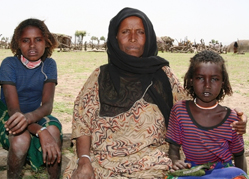News
Two More Corners of Ethiopia Call for an End to Genital Cutting
- 02 February 2012
News
AFAR REGION, Ethiopia — In a ceremony of poetry, drama and music, the Buremudaytu and Argoba districts in the Afar region officially abandoned female genital mutilation/cutting earlier this month. The event– attended by government and religious leaders, clan elders, former circumcisers and other community officials – was a remarkable achievement in an area where an extreme form of FGM/C was almost universally practiced for centuries. The districts of Amibara, Awash Fentale and Gewane officially stopped cutting in December 2010.
The collective declarations represent the culmination of years of work by local organizations including the Afar Region Bureau of Women, Children and Youth Affairs, the Afar Pastoralist Development Association and the Rohi Weddu Pastoralist Women’s Development Organization. The success of their efforts, conducted with support from the UNFPA-UNICEF Joint Programme to Accelerate Abandonment of FGM/C, validates their approach to changing social norms.
Creating a new social norm
The groups begin by building on the convictions of those individuals within the community who already question FGM/C. Then, through information and discussions, they try to convince enough others so as to create a tipping point – a rapid shift to a new consensus about FGM/C, which was linked to a girl’s social status in the past. Collective community decisions and declarations are encouraged as a way to reverse longstanding social norms without subjecting individual girls or their families to ostracism.
Social norms are changing in Afar, a hot, arid pie-shaped region in the northeast of Ethiopia, inhabited mostly by pastoralists. Although FGM/C has been almost universally practiced here in the past, the number of uncircumcised girls in Buremudaytu has reached 1,120, while all 106 girls born last year in Argoba district remain uncut. (In some places, the cutting occurs in the first days of birth.) Recent figures show that the number of uncut girls in the six Afar districts has reached 7,000, up from about 4,000 in 2010.
Dohra Ali decides to change
Dohra Ali, a former circumciser in the Doho locality, was forced to confront the issue when her young daughter one day asked: “Mother, is there a place in this world where FGM is not practised where I could go to?”

Looking back, Dohra said her daughter’s question was prophetic. A campaign to abandon female genital mutilation/cutting began in the region about that time – in 2000. It was mainly led by religious leaders, who worked to undo the misperception that FGM/Cis supported by Islam. This was news to many people, who had grown up with the idea that cutting was a religious requirement.
Dohra was fiercely opposed to the campaign at first, but she was persuaded eventually when the religious leaders held discussions with her community and condemned the practice. Once she learned that cuttingwas not supported by Islam, Dohra resolved to spare her five daughters from the ordeal and to stop her own practice. Despite ridicule by some members of her community, she joined the anti-FGM/C campaign.
New directions
Though the overriding focus remains on abandoning FGM/C, other work on harmful traditional practices is being discussed in the community dialogue process. For instance, in Afar people believe that the girls will engage in sex or get raped if they are not married by age 15, which puts pressure on them to marry early. But efforts are under way to push the age of marriage of girls to 18 by helping them attend school. Accordingly, girls’ education has increased in recent years, and the members of the anti-FGM committees, like Dohra Ali, are playing a model role by sending their own daughters to school.
In addition, UNFPA is supporting integration of FGM/C with other reproductive health care services. Male health workers, women health extension workers and traditional birth attendants have been trained and deployed to improve access to reproductive health services, provide prenatal care and post-natal care services. The health workers also provide advice and follow-up care to women who have been infibulated – which can create obstetric complications -- to deliver their infants at health facilities or to plan for a skilled health worker to attend the birth.
— Abraham Gelaw